About ten years ago, a team at the National Museum of Natural History set out to reinvent their aging fossil halls for a new generation. Paleontology exhibitions had occupied the building’s east wing since 1911, and while there had been several renovations and additions, these were always additive. The result was a crowded and jumbled space, a hodge-podge of displays created by different people, at different times, for different reasons. In the early 2000s, a new core team—including Project Manager and Developer Siobhan Starrs, Designer Pauline Dolovich, and Curators Matt Carrano, Kay Behrensmeyer, and Scott Wing—had a once-in-a-lifetime opportunity to clear the east wing from wall to wall and start over with a blank slate. Their task was to fill 31,000 square feet with the story of life on Earth, with the latest science and a modern understanding of how visitors use museums in mind.
The result is breathtaking. Deep Time, as the new exhibition is colloquially known, sets a high standard for excellence in natural history exhibitions. What follows is a brief discussion of some the hall’s many successes. I will undoubtably have more to say in the coming weeks.
Themes
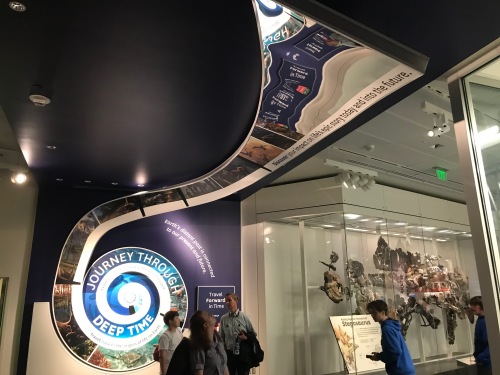
The Time Spiral, illustrated by Julius Csotonyi, appears at both entrances to Deep Time. It is the spiritual successor to John Gurche’s Tower of Time.
As has been well publicized, Deep Time contains a strong message about how humans are changing the Earth in unprecedented ways. This is introduced the moment visitors enter the exhibition, with an illustrated spiral of time that ends in a mirror. The implication is simple, but direct: we are part of the story of our planet.
Throughout the hall, visitors are reminded of humanity’s connection to the rest of the planet in different ways. In one corner, an interactive (admirably starring a gender-neutral cartoon host) illustrates the evolutionary origins of different features of the human body. In the Quaternary section, large graphics present the percentage of megafauna on each continent that went extinct as humans spread around the globe.
The hardest-hitting message, however, is about the modern climate crisis. The fact that industrial activity is profoundly warming the climate—a change that comes with dire consequences—is presented in clear, matter-of-fact language. It’s not preachy, it’s not political, it’s just the truth. The exhibition does not explicitly say we should stop harming the planet (although we should), but it clearly presents the evidence that we are, and that we have the ability to stop. This information is centered on an overlook called “the bridge.” The centrality of this location and its proximity to the dinosaurs makes the climate narrative unmissable. The nature of the modern media landscape is such that many NMNH visitors may well have never seen this message presented in non-political terms. I’m eager to see the results.
Layout
One of the earliest decisions in Deep Time’s development was to restore the original architecture. This had already been done in the north and west wings for the Ocean and Mammals halls, and restoring the east wing would bring back the building’s intended symmetry. This choice dovetailed with an acknowledgement of visitors’ tendency to pinball around an exhibition, rather than view displays in a prescribed order. The team decided to welcome this spirit of exploration. The new hall can be navigated in any order, but still makes sense as a cohesive story.
Most of the displays are on island platforms. Each platform represents a particular time period, and for the most part, specimens displayed together represent species that would have coexisted in a single ecosystem. Big, show-stopping skeletons are in the center, while smaller specimens and accompanying labels and interactives can be found around the perimeter. Vertical pillars, which are visible from across the hall, indicate where each platform is in time. Meanwhile, mass extinctions are represented by large walls that physically divide the space. The result is a hall where it’s always clear whether the display you’re looking at is earlier or later in time than any other display, even though you can circulate among the islands at will.
NMNH gets several million visitors each year, so traffic flow is a major concern. This was a problem in the old hall, where decades of partial renovations had resulted in several frustrating bottlenecks. The new hall allocates nearly 50% of its floor space to visitor movement. A central avenue allows quick movement around the exhibition. Visitors short on time can pop in and “snack” on a few displays, rather than investing in the whole meal. Unlike linear exhibitions, visitors can backtrack without disrupting the traffic flow.
Furthermore, most of the hall can be viewed from multiple perspectives. Another function of the bridge is to provide an elevated vantage point. From the overlook, visitors can see Tyrannosaurus and Diplodocus over the heads of the crowd. Digital interactives show highlights on a 3-D model of the hall, helping visitors think about the entire history of life all at once. Actually, this is one area where I wish the developers had gone further. I would have loved to see displays that encouraged visitors to compare the animals visible on either side of the mass extinctions, or to think about what environmental factors led to the evolution of very different megaherbivores (the sauropods and proboscideans) at different points in time.
Animals
Lead Curator Matt Carrano came to the project with a vision. He wanted the mounted skeletons to read as animals, not as monsters or trophies. That meant they should be doing the sorts of things that animals do. Nearly every mount tells a story. The well-publicized Tyrannosaurus is dismembering a Triceratops: look closely and you’ll see fractured ribs, a broken horn, and that the Triceratops‘s head is actually separated from its body. The Eremotherium is plucking Osage oranges from a tree, referencing the hypothesis that these inedible fruits were cultivated by recently-extinct megafauna. A Menoceras is lying on its side in a characteristic rhino resting pose. The Stegoceras is scratching its jaw. Each pose gives the mounted skeletons a reality that is rarely seen in fossil exhibits. These are the remains of once-living creatures, after all. They got hurt, hungry, tired, and itchy.
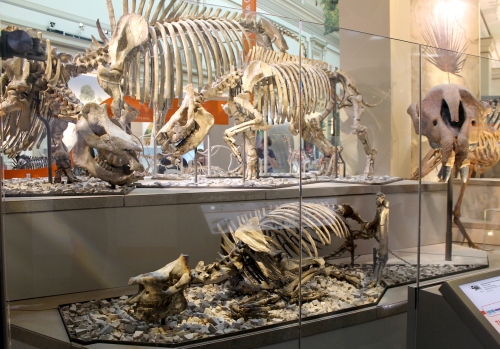
Although the resting Menoceras bears a certain resemblance to the Roosevelt white rhino on the other side of the museum, this was a lucky accident rather than a deliberate quote.
Another more subtle reason these mounts are so successful is that the animals’ feet are always touching the ground. Many mounted skeletons are elevated on their supports, which makes the interplay between the armature and the base (typically built separately) easier to manage but also makes the skeletons look like they’re hovering. Grounding the animals’ feet was extremely challenging: ultimately, beds of gravel were used to smooth out the point of contact. Few visitors are likely to notice this achievement specifically, but the result is that each skeleton is imbued with weight and energy rarely seen in similar displays.
Research Casting International prepared and constructed most of the mounted skeletons, while NMNH preparators handled the rest in-house. The scope of the mounting and remounting of fossil skeletons for Deep Time is probably unprecedented. For comparison, the renovation of the American Museum of Natural History paleontology halls in the mid 90s involved two remounts (Tyrannosaurus and Apatosaurus) and around ten new skeletons. By my rough count, Deep Time has 40 remounts and 13 brand-new mounts, to say nothing of the work that went in to dismantling the skeletons from the old hall that have been returned to collections.
Discovery
It wasn’t until my second day exploring Deep Time that I noticed the dioramas cycle between day and night. I can only imagine the challenge the designers faced in arguing for this feature. It doesn’t have any particular educational purpose, after all, and only a small fraction of visitors are likely to notice it. Still, for those who do notice (I’m picturing a child poring over every detail of the miniature landscape while their parents wait impatiently), the effect is beautiful and magical. Those are the moments exhibition creators strive for.
A stroll through Deep Time is filled with similar moments of discovery, on many different scales. Follow the gaze of the two bronze Ice Age humans and you’ll realize they’re reacting to the Smilodon stalking nearby. Look beneath the platforms where Tyrannosaurus and Dimetrodon are standing and find a secret world of freshwater fossils. Although there are few levers to pull and wheels to turn in the exhibition, tactile experiences abound. There are touchable fossil casts, and a plethora of life-sized bronzes to interact with. I’m particularly enamored with the Mesozoic and early Cenozoic mammals: these are difficult to conceptualize with fossils alone and the bronzes bring them to digging, scratching, yawning life.
There are a hundred more examples, but I should stop for now. In short, Deep Time is an incredible exhibition. You should visit, and then visit several more times, because you’ll undoubtably discover new things to wonder at.
Reference
Marsh, D.E. 2019. Extinct Monsters to Deep Time: Conflict, Compromise, and the Making of the Smithsonian’s Fossil Halls. New York, NY: Berghan Books.

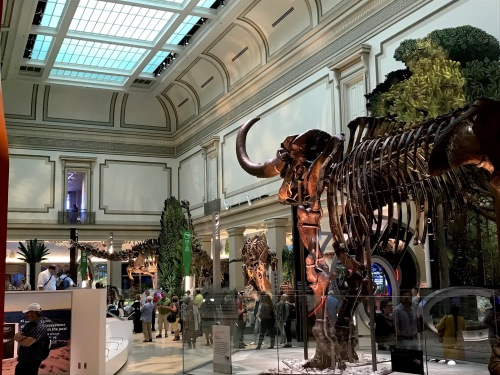
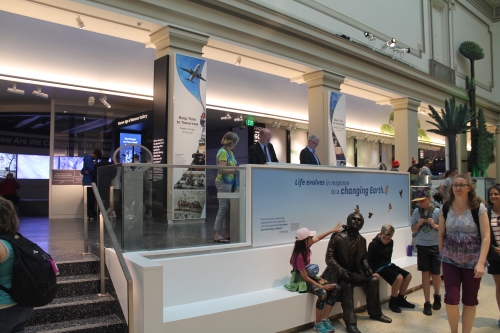
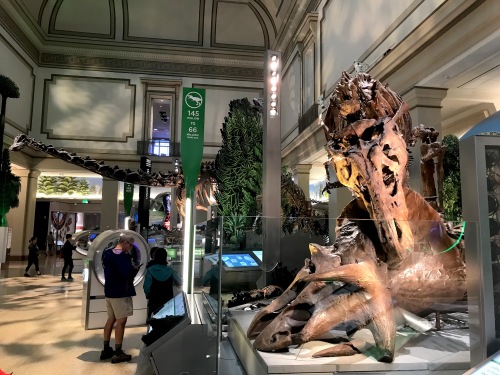
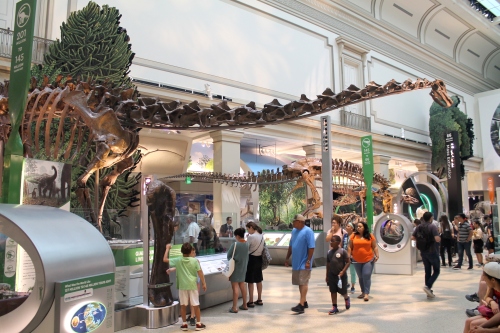


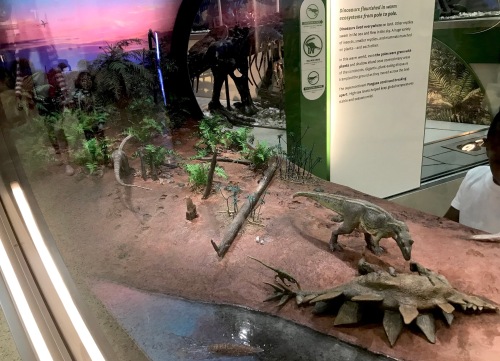
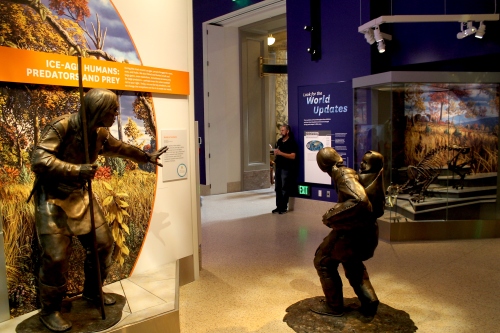


Amazing! This alone is an excuse for me too go back too the US and visit Washington (just did NY and a stop in LAX)!
I’m impressed they kept the climate stuff as objective as possible, from both a sense of scientific reasonability and too not trigger anybody.
It’s also good too see they had a sense of humour when designing elements of it!
I am in DC right now visiting the NMNH for the second day. Have been looking forward to the reopening since I visited in 2017 and found out the hall was closed. The initial sense I got from the preview pics is that the Diplodocus and T-Rex were the only major displays, but each island indeed has specimens all around it. Reading this review helped me believe it would be worth the trip and it was, so thank you. Only regret is that I didn’t get to see the original hall that I had seen in many classic documentaries (same with Carnegie).
Hi mjp81. I remember the last major renovation to the Fossil Hall, in December 1981 (I was 5-there was a dinosaur film festival and in a pre-web world dino clips were hard to find 😉 ) If you want to see a free documentary about the old Fossil Hall, it can be found here.
Best Ariel Segal
Ah yes, the Secrets of the Fossil Hall documentary. I have watched that before and it does give many interesting insights on the old Fossil Hall.